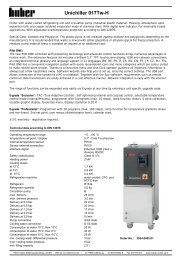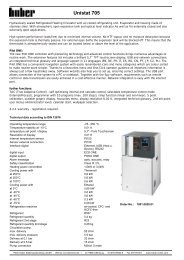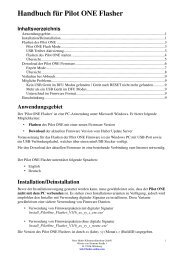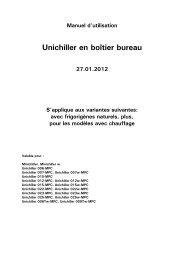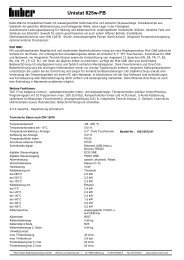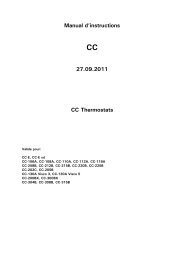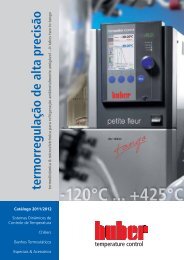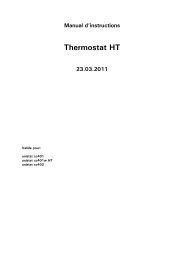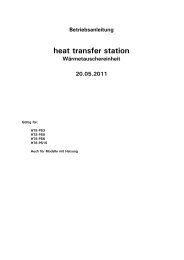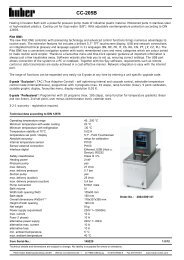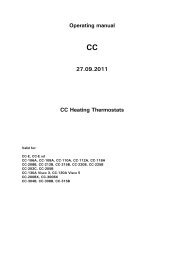Plug & Play - HUBER
Plug & Play - HUBER
Plug & Play - HUBER
Create successful ePaper yourself
Turn your PDF publications into a flip-book with our unique Google optimized e-Paper software.
A Ambient Temperature Range<br />
126 www.huber-online.com<br />
Glossary<br />
Ambient Temperature Range is the permissible temperature<br />
range of the environment in which the unit will function. lt<br />
is 5...40 °C for all Huber units in this catalogue. The quoted<br />
cooling powers are for an ambient temperature of 20 °C.<br />
B Bath Opening<br />
is the usable surface that is available for direct thermoregulation,<br />
as a rule over the entire usable depth.<br />
Bath Thermostat<br />
is a thermostat which is equipped with a pump and a bath<br />
that contains the object to be thermoregulated. The built-in<br />
circulating pump is used to mix the bath liquid, but can also<br />
be used if necessary to circulate the thermal fluid through<br />
an externally connected circuit, e.g. connection of a flowthrough<br />
cooler to allow the cooling of heating thermostats.<br />
Bath/Circulation Thermostat<br />
is a thermostat with a bath opening which allows objects<br />
to be directly thermoregulated in the bath, but also includes<br />
a pump for external closed or open applications. Note:<br />
pressure & suction pump is required for open applications.<br />
Compatible Control thermostats have pressure & suction<br />
pump.<br />
Bath Volume (also fill volume)<br />
is the volume of the bath liquid that is required for adequate<br />
operation of the thermostat, but without considering the<br />
volume of thermal fluid in the external circuit. lf two values<br />
are given, the lower value indicates the minimum required<br />
volume with displacement insert, the upper value the permissible<br />
maximum amount. The difference is the so-called<br />
expansion volume. Especially in the case of external applications,<br />
the size of the expansion tank must be considered,<br />
since the circulating thermostat must also take up the expansion<br />
of the liquid in the external circuit. The smaller the<br />
surface area of the expansion tank the lower is the area of<br />
thermal fluid open to attack from oxidation and air humidity<br />
absorption.<br />
C Calibration Thermostat (CAL)<br />
is a bath thermostat with especially high temperature stability<br />
and especially consistent temperature distribution<br />
through the bath.<br />
Clear-view Thermostat<br />
is a bath thermostat with transparent walls for direct observation<br />
of the object being thermoregulated.<br />
D Discharge Pressure<br />
is the positive pressure of the circulating pump of a thermostat<br />
directly at the pump discharge. lf only one value is<br />
given in the tables, then this involves the maximum delivery<br />
pressure for flow rate zero. Pump curves illustrate discharge<br />
in relation to the flow rate.<br />
E E-grade ®<br />
stands for electronic upgrade. E-grade can extend the functionality<br />
of the CC-Pilot. A unit specific activation code is<br />
required. This can be carried out in the factory. If ordered at<br />
a later date the activation code can be sent by E-Mail.<br />
Extended Working Temperature Range<br />
Extended Working Temperature Range is the temperature<br />
range that can be attained when using a factory-fitted cooling<br />
coil when operating with cooling water.<br />
F Flow Rate<br />
is the volume of liquid delivered per time unit by the circulating<br />
pump measured with water. If only one value is given<br />
in the table, this is the maximum flow rate for a zero<br />
discharge pressure. Pump curves illustrate discharge in<br />
relation to the flow rate.<br />
Flow-through Chillers (DC ® )<br />
are add-on coolers which are connected into an external<br />
circuit to upgrade a heating thermostat to a heating/cooling<br />
thermostat. They are used to replace water cooling,<br />
and also to extend the Iower operating temperature.<br />
H Heat Load<br />
is the maximum capacity of the installed electric heater. The<br />
heating is controlled proportionally. The heating is continually<br />
controlled, and as the set point temperature is approached<br />
the power is reduced automatically.<br />
Heating Thermostat<br />
is a thermostat whose working temperature range is primarily<br />
above the ambient temperature adds heat to the thermal<br />
fluid.<br />
I lmmersion Cooler<br />
is an additional chiller with a flexible tube and a cooling coil<br />
(evaporator) for immersion cooling of any desired bath.<br />
lmmersion Thermostat<br />
is a thermostat that can be combined with a bath and to<br />
form a complete unit. Immersion thermostats are equipped<br />
with a screw clamp to attach them to any desired bath wall<br />
or can be fixed on a stand. Immersion thermostats can also<br />
be fitted to a bridge and mounted permanently in a bath.<br />
Industrial Thermostats (UC ® -Hx)<br />
are refrigerated circulators (Unichiller range) with factory<br />
fitted heating. The units have high cooling, heating and<br />
pump powers which allow quick cooling and heating rates<br />
due to the small internal volumes. They are ideal for temperature<br />
control in process technology, within a smaller temperature<br />
range (-20 to 120 °C).<br />
Interface, analogue<br />
is used to input the set value or to output the actual value<br />
of temperature in analogue form, generally in the form of a<br />
current (0/4–20 mA or 0–10 V).<br />
Interface, digital<br />
is used to transfer data between connected units in digital<br />
form via data cable. The set and actual temperature values<br />
are the main items transferred. The serial RS232 interface<br />
allows a point-to-point connection. This means that at anyone<br />
time only two participants such as the thermostat and<br />
the PC can communicate with each other via the interface.<br />
The RS485 interface is an addressable interface where up<br />
to 32 participants can be connected. Each participant of<br />
the bus system has its address.<br />
Intrinsic Temperature<br />
is the operating temperature of a heating thermostat that<br />
is reached when the heating is switched off. lt depends on<br />
the pump power, thermal fluid (viscosity and density) used<br />
and the insulation of the thermostat, e.g. with or without a<br />
cover on the bath.<br />
N Net Cooling Capacity<br />
is the effective capacity available in refrigeration thermostats<br />
or circulating chillers. This is the net cooling power of<br />
the unit after the frictional heat produced by the circulating<br />
pump and the heat entering as a result of non-ideal insulation<br />
has been subtracted.<br />
O Operating Temperature Range<br />
Operating Temperature Range is the temperature range<br />
that is limited by the permissible lowest and highest operating<br />
temperatures.<br />
P Pressure/Suction Pump<br />
This pump has a pressure and a suction stage which are<br />
driven by the same motor. The thermal fluid is delivered<br />
from the pressure stage from the thermostat into the circuit,<br />
and the suction stage draws the liquid back into the<br />
thermostat. A pressure/suction pump can be used in just<br />
the same way as a pressure pump for a closed circuit. lt has<br />
the advantage compared to a pressure pump that the pressure<br />
in the external circuit falls from positive values (pressure)<br />
in the flow line to negative values (suction) in the return<br />
line and is almost zero in the application itself. Thus it is<br />
suitable for the thermoregulation of pressure-sensitive



